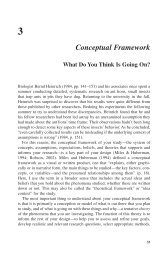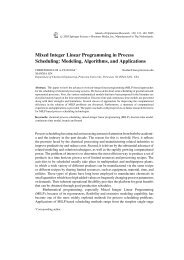Qualitative Research Basics: A Guide for Engineering Educators
Qualitative Research Basics: A Guide for Engineering Educators
Qualitative Research Basics: A Guide for Engineering Educators
You also want an ePaper? Increase the reach of your titles
YUMPU automatically turns print PDFs into web optimized ePapers that Google loves.
Department records, rather than Education Department records. Overall, one must<br />
plan carefully <strong>for</strong> access to archives, but also be flexible in their use.<br />
Printed Media and Literature: This type of material includes publicly available<br />
reports, mass media, and literature. Much of this material is often created <strong>for</strong><br />
advocacy purposes, and so care must be taken in interpreting their contents. One<br />
useful way of using these materials is to examine them in light of the broad social<br />
issues that they reflect. One can use them to understand the specific social context<br />
of a time period (past or present), or to trace broad social changes that occur over<br />
time. However, McCulloch points out that such documents, particularly<br />
government reports, should not be assumed to accurately portray how policies are<br />
enacted. Rather, “The influence of reports is often far less than their authors<br />
imagine, and they may be read and interpreted in ways that are not anticipated”<br />
(p. 83). Another way in which these documents can be understood is by<br />
examining the discourses that the document represents; that is, the particular<br />
assumptions and arguments that are used to define a particular worldview.<br />
Comparison across many documents can often reveal these assumptions and make<br />
clear what is being omitted.<br />
Diaries, Letters, and Autobiographies: All of these types of documents share the<br />
common characteristic that they provide a personal view of events and issues.<br />
However, there are important distinctions to be made among them. Diaries (and in<br />
more recent times blogs) often (although not always) provide an immediate<br />
description, with the emotions and reactions unaffected by time or reflection.<br />
Here, as McCulloch, points out, one must careful to consider the motivation <strong>for</strong><br />
writing the diary or blog. In some cases it is a personal creation, not written with<br />
the explicit intention of being read by others. In other cases, however, they are<br />
written with the intent of being published or to espouse a certain view. This may<br />
be more descriptive of blogs than diaries, since by their nature blogs are<br />
immediately available <strong>for</strong> public reading. Letters are different, in that they<br />
represent a two-way exchange between the writer and the reader. Again, there are<br />
different categories of letters; some are “official” and seek to persuade or to<br />
provide a view on a public matter. Others are more personal. However, the<br />
distinction between these two types can be blurred. McCulloch provides several<br />
examples of personal letters that also reveal in<strong>for</strong>mation about development of<br />
public policy. Autobiographies provide a personal view, but without the<br />
immediacy of diaries of letters. Events and their interpretation are modified<br />
through difficulties in memory, a desire to espouse a certain point of view, or an<br />
attempt to show the events in one’s life as contributing to an overall theme. Even<br />
though autobiographies are the telling of one person’s life, they can “offer<br />
interesting insights into broader social and public dimensions” (p. 121).<br />
Throughout his book, McCulloch offers many examples of how these different<br />
types of documents can shed light on issues impacting education. Minutes of<br />
government agency meetings, diaries and letters of political figures, and policy<br />
documents all provide insight into the development of educational policies.<br />
34
















